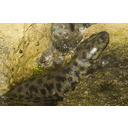Amphibian class
The amphibians (from the Greek, amphi, "both" and bios, "life", which means "both lives" or "both ways") are a class of anamniotes vertebrates (without amnion, such as fish), tetrapods, ectotherms, with gill respiration during the larval phase and pulmonary when reaching the adult stage.
Amphibians have not managed to become independent of water, since their larvae, the tadpoles, are aquatic, but when they reach adulthood, with metamorphosis, although they can live on land, they need to live in humid areas to avoid dehydration.
Amphibians are tetrapods, with four limbs adapted to the terrestrial environment.
Larvae of amphibians are herbivores, but when amphibians are adults they are carnivores. They are able to catch their prey (insects, other invertebrates,...) with their sticky tongue and swallow them without chewing.
Amphibian larvae have gill respiration. Adults, on the other hand, have pulmonary and cutaneous respiration . For this reason, they have very thin skin, without scales or feathers or hair, and it is always moist so that gaseous exchange can take place . Some species have glands that secrete poison.
Your heart is divided into two atria and one ventricle.
They are ectotherms, so they cannot live in very cold places, as they go dormant when it is very cold.
Reproduction in amphibians is sexual with external fertilization. That is, the union of eggs and sperm occurs outside the female's body.
Amphibians are oviparous, they reproduce by laying eggs in water or in very humid places to avoid drying out.
![Salamander (Salamandra salamandra). By David Perez [GFDL (http://www.gnu.org/copyleft/fdl.html) or CC BY 3.0 (https://creativecommons.org/licenses/by/3.0)], from Wikimedia Commons](salamandraThumbnail.png)
![Pyrenean Newt (Euproctus asper). By DAGOR53 [CC BY-SA 3.0 (https://creativecommons.org/licenses/by-sa/3.0)], from Wikimedia Commons](triton_pirenaicoThumbnail.png)

